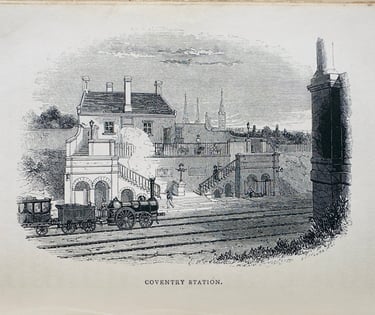Balanced on the edge of the emerging railway nation but with its feet firmly set in the great coaching age, the London & Birmingham railway in its early years displayed all the character of the Regency to Victorian transition. New technology delivered in the trappings of the old style. The mainline railway still had a lot of work to do to assure the rich particularly, who had a choice of travel, of its safety and they did so by distracting with familiar features and luxurious style. Monumental architectural designs that reflected permanence and solidity, contrasted with small locomotives and carriages still drawing upon coaching age engineering. With in a few very busy years everything would change, this is drastically revealed and encapsulated in the short history of Coventry’s first station (1838-1840). Remembered for its Euston Arch (propylaeum) and also for the recent archaeological discoveries at its Curzon Street Birmingham terminus, The London & Birmingham Railway has, despite its plethora of archival and detailed information, never probably been studied. Numbers of books covering superficial history, often dissolving into pictures of Euston in LMS days, do insufficient justice to the original company and what it achieved, they also reveal little of the day to day workings. There is still much of the railway’s history, context and importance as a source of design and railway practice to be revealed.


This project, given the fantastic realisation of Chris Cox’s expert modelling, has steered me to investigate an aspect of line’s working from the perspective of a single intermediate station. In this context I have looked also more widely at the work of the architect, George Aitchison (senior) and the original concept of how these stations were thought to work. Coventry, a great medieval city with royal connections, was deemed important enough to have a primary intermediate station, called a first class station due to its importance, although not exclusively for first class passengers.
This station was born of the earliest concept of intermediate stations and like much of the history of the early London & Birmingham railway proved deficient in the face of the rapid evolution of the early mainline railway. The first Coventry station of 1838 was entirely replaced by a new modern style station in 1840, quite possibly to the design of Francis Thompson, and George Aitchison, an employee of the company since 1836, was let go by the London & Birmingham, a change over perhaps symbolic of the movement from the old Georgian order to that of the New Victorian age. Coventry 1839 as a project is an opportunity to enjoy a historical moment in time with some unique blends of early London & Birmingham history, expertly and accurately modelled by Chris Cox..
TN - 25/1/2023


A Project in Historical Railway Modelling from Chris Cox (modelling/research) & Tom Nicholls (research)
Top illustration (c.1838/9) - This image has proved to be the most accurate in the form and feel of the station between 1838 and 1840. The History articles on this website reveal the plans of the architect George Aitchison (working under Philip Hardwick) and Chris' modelling brings this scene, consigned for so long to history, back to life. Copy: Chris' own collection, Osborne's London and Birmingham Railway guide. Illustrated. (1840), Osborne, Edward Cornelius.
The London & Birmingham railway coat of arms are a traditional format for railways at the time, in that the arms of both cities are combined to form the railway company's arms. There are several versions of the arms from ovals to plain shields and varying in supporters and decoration. These are displayed on the fore page of the origin plans found in the National Archives (Rail 384 192) and show a variation most likely the work of the draftsman.
